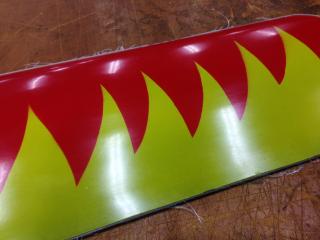I made up the 4 moulds yesterday evening using the 3 plugs pictured in my last post and the plug for the front Hatch, I have already made a mould for that but the finish on it is not so great so I thaught while I was at it, I might as well do that one again at the same time.
The good thing about making composite parts is that once you have a good plug it is very easy to make a mould and once you have a mould it's even easier to make the parts from it.
If the mould gets damaged or wears out, it’s a simple matter to go back and make another mould from the plug.
The Key to success with any fibre glass work is planning. Everything must be ready, all the glass must be measured and cut and set out in the order it goes on. All the tools, fillers, brushes, hand-towl, gloves ect, must be on hand before the resin is mixed. If there’s anything tricky about the job, have a plan B in place as well. Once the resin is mixed, it’s starting to cure and everything must be done before that happens.
The plugs were prepared with 6 coats of TR-8 silicon free mould release wax, rubbed on and then rubbed off again. Then three spray coats of PVA mould release on top of that.
I used this little spray gun I got from Ebay for $32 including postage.
http://www.ebay.com.au/itm/181116094682?...K:MEWNX:IT&_trksid=p3984.m1439.l2649
It’s not a superb spray gun and the fan spray pattern is a little bit denser on the bottom than on the top but it does a nice enough job if it’s carefully adjusted, for the money it’s good value.
It’s not the one I used to spray the Upol-reface, this gun only has a 0.8 mm nozzle and you need a 2.5 for the Upol. The smaller nozzle is better for spraying thin stuff like PVA
There are many ways to make moulds but this the way I went about it.
Once the plug is prepared as above
All you do is mix up some gel-coat and paint it thickly on the plug. When the gel-coat is solid but still tacky mix up some resin. Pour a small amount of mixed resin aside and add some filler to make a stiff bog that won’t slump. A good filler for this is “west systems microfiber blend”, spatula this into any tight corners where it’ll be hard to work the glass cloth into. Once this is done, using the rest of the resin begin by laying up a couple of layers of light cloth either 3 or 4 Oz. Then a couple of 6 Oz then some heavier stuff to back it with, use either cloth or chopped strand mat. Wet it out between the layers and stipple it down with a brush. The layup I used totalled about 60 Oz per sq ft when the cloth ws added up. The thicker glass cloth on the back was fire blanket that I had left over from another job. But a couple of layers of 24 oz, or 4 of 12 Oz would do. Biaxial cloth could also be used, it is good because it’s thick and it will still take a shape quite nicely where as heavy woven cloth is a bit harder to coerce into and around corners.
The moulds were made using polyester tooling gel and polyester laminating resin. The parts that will be moulded from them will made using epoxy resin.
These moulds were a bit of a trial as I’d never used Upol-reface as a finish for a plug before. I hadn't forgotten the enamel debacle, which cost me quite a bit of time, so it was with more than a little trepidation, that I gently pried the moulds from the plugs. I was really very happy to see that they all worked extremely well. There were a few places where I had put the gel-coat on a little thin, this shows up slightly in the colour of the moulds but has, in no way effected the surface finish. I certainly can’t blame the Upol reface for that. All in all, it worked brilliantly !! I will definitely be using it again.


All that was left to do was to mark out the flange of the moulds and cut the edges to shape

Here’s a pic of the finished moulds and their plugs.











 paaatience !!
paaatience !! paaaaaatience
paaaaaatience  paaaaaaatieeence
paaaaaaatieeence  dooooohhhh !!!
dooooohhhh !!! 

